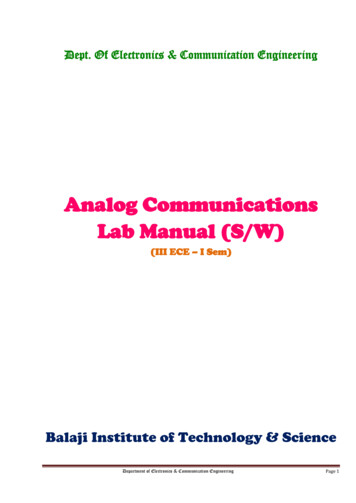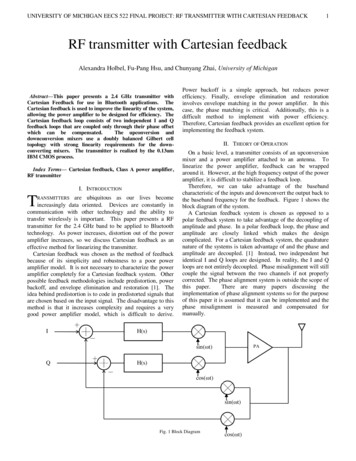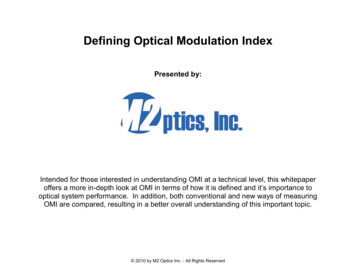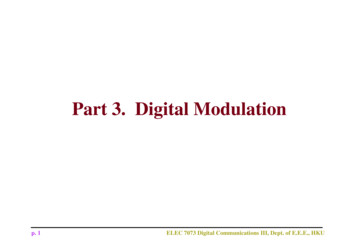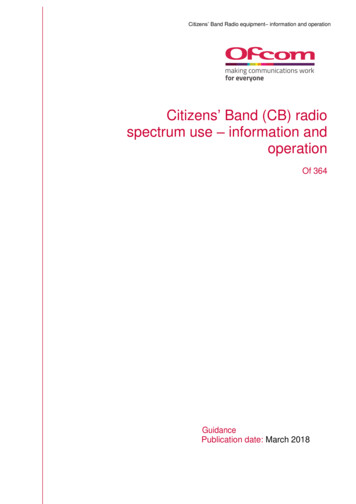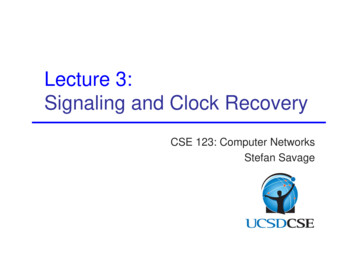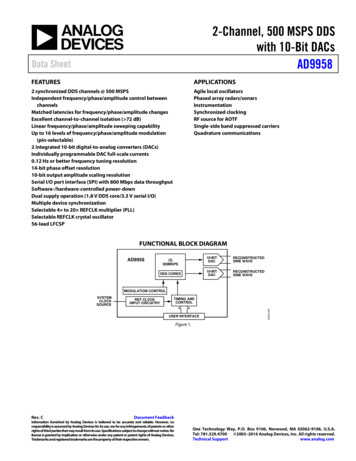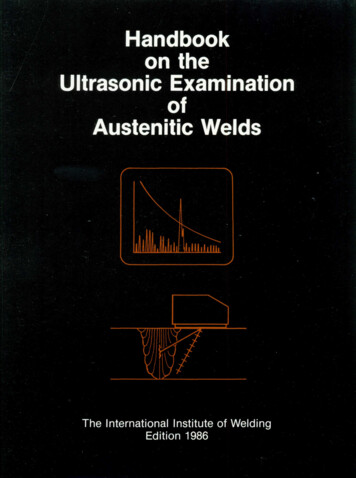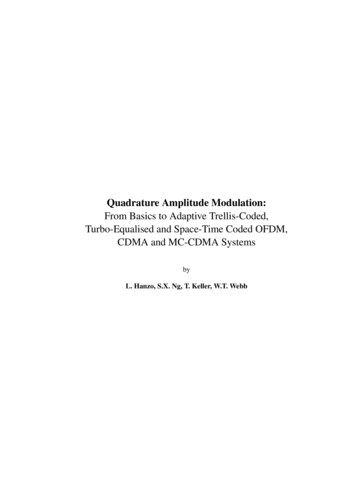
Transcription
Quadrature Amplitude Modulation:From Basics to Adaptive Trellis-Coded,Turbo-Equalised and Space-Time Coded OFDM,CDMA and MC-CDMA SystemsbyL. Hanzo, S.X. Ng, T. Keller, W.T. Webb
ContentsAbout the AuthorsxxiiiRelated Wiley and IEEE Press BooksxxvPrefacexxviAcknowledgementsxxviiiI QAM Basics11Introduction and Background1.1 Modulation Methods . . . . . . . . . . . . . . . . . . . . . . . . . .1.2 History of QAM . . . . . . . . . . . . . . . . . . . . . . . . . . . . .1.2.1 Determining the Optimum Constellation . . . . . . . . . . . .1.2.1.1 Coherent and Non-Coherent Reception . . . . . . .1.2.1.2 Clock Recovery . . . . . . . . . . . . . . . . . . .1.2.1.3 The Type I, II and III Constellations . . . . . . . .1.2.2 Satellite Links . . . . . . . . . . . . . . . . . . . . . . . . .1.2.2.1 Odd-Bit Constellations . . . . . . . . . . . . . . .1.2.3 QAM Modem Implementations . . . . . . . . . . . . . . . .1.2.3.1 Non-Linear Amplification . . . . . . . . . . . . . .1.2.3.2 Frequency Selective Fading and Channel Equalisers1.2.3.3 History of Blind Equalisation . . . . . . . . . . . .1.2.3.4 Filtering . . . . . . . . . . . . . . . . . . . . . . .1.2.4 Advanced Prototypes . . . . . . . . . . . . . . . . . . . . . .1.2.5 QAM for Wireless Communications . . . . . . . . . . . . . .1.3 History of Near-Instantaneously Adaptive QAM . . . . . . . . . . . .1.4 History of OFDM-based QAM . . . . . . . . . . . . . . . . . . . . .1.4.1 History of OFDM . . . . . . . . . . . . . . . . . . . . . . . .1.4.2 Peak-to-Mean Power Ratio . . . . . . . . . . . . . . . . . . .1.4.3 Synchronisation . . . . . . . . . . . . . . . . . . . . . . . .v.22556771011111313141516171923232425
viCONTENTS1.4.41.4.51.4.61.51.61.71.82OFDM/CDMA . . . . . . . . . . . . . . . . . . . . . . . . . . . . .Adaptive Antennas in OFDM Systems . . . . . . . . . . . . . . . . .Decision-Directed Channel Estimation for OFDM . . . . . . . . . .1.4.6.1 Decision-Directed Channel Estimation for Single-UserOFDM . . . . . . . . . . . . . . . . . . . . . . . . . . . .1.4.6.2 Decision-Directed Channel Estimation for Multi-UserOFDM . . . . . . . . . . . . . . . . . . . . . . . . . . . .1.4.7 Detection Techniques for Multi-User SDMA-OFDM . . . . . . . . .1.4.8 OFDM Applications . . . . . . . . . . . . . . . . . . . . . . . . . .History of QAM-Based Coded Modulation . . . . . . . . . . . . . . . . . .QAM in Multiple Antenna Based Systems . . . . . . . . . . . . . . . . . . .Outline of the Book . . . . . . . . . . . . . . . . . . . . . . . . . . . . . . .1.7.1 Part I: QAM Basics . . . . . . . . . . . . . . . . . . . . . . . . . .1.7.2 Part II: Adaptive QAM Techniques for Fading Channels . . . . . . .1.7.3 Part III: Advanced QAMAdaptive OFDM Systems . . . . . . . . . . . . . . . . . . . . . . .1.7.4 Part IV: Advanced QAMTurbo-Equalised Adaptive TCM, TTCM, BICM, BICM-ID andSpace-Time Coding Assisted OFDM, CDMA and MC-CDMA SystemsSummary . . . . . . . . . . . . . . . . . . . . . . . . . . . . . . . . . . . .Communications Channels2.1 Fixed Communication Channels . . . . . . . . . . . . . . . . . . . . .2.1.1 Introduction . . . . . . . . . . . . . . . . . . . . . . . . . . . .2.1.2 Fixed Channel Types . . . . . . . . . . . . . . . . . . . . . . .2.1.3 Characterisation of Noise . . . . . . . . . . . . . . . . . . . . .2.2 Telephone Channels . . . . . . . . . . . . . . . . . . . . . . . . . . . .2.3 Mobile Radio Channels . . . . . . . . . . . . . . . . . . . . . . . . . .2.3.1 Introduction . . . . . . . . . . . . . . . . . . . . . . . . . . . .2.3.2 Equivalent Baseband and Passband Systems . . . . . . . . . . .2.3.3 Gaussian Mobile Radio Channel . . . . . . . . . . . . . . . . .2.3.4 Narrow-Band Fading Channels . . . . . . . . . . . . . . . . . .2.3.4.1 Propagation path loss law . . . . . . . . . . . . . . .2.3.4.2 Slow fading statistics . . . . . . . . . . . . . . . . .2.3.4.3 Fast fading statistics . . . . . . . . . . . . . . . . . .2.3.4.4 Doppler spectrum . . . . . . . . . . . . . . . . . . .2.3.4.5 Simulation of narrowband channels . . . . . . . . . .2.3.4.5.1Frequency domain fading simulation . . . .2.3.4.5.2Time domain fading simulation . . . . . . .2.3.4.5.3Box-Müller algorithm of AWGN generation2.3.5 Wideband Channels . . . . . . . . . . . . . . . . . . . . . . .2.3.5.1 Modelling of Wideband Channels . . . . . . . . . . .2.4 Mobile Satellite Propagation . . . . . . . . . . . . . . . . . . . . . . .2.4.1 Fixed-Link Satellite Channels . . . . . . . . . . . . . . . . . .2.4.2 Satellite-to-Mobile Channels . . . . . . . . . . . . . . . . . . .2.5 Summary . . . . . . . . . . . . . . . . . . . . . . . . . . . . . . . . 6575961616667686969707074747475
CONTENTS34Introduction to Modems3.1 Analogue-to-Digital Conversion3.2 Mapping . . . . . . . . . . . . .3.3 Filtering . . . . . . . . . . . . .3.4 Modulation and Demodulation .3.5 Data Recovery . . . . . . . . . .3.6 Summary . . . . . . . . . . . .vii.77777981848586Basic QAM Techniques4.1 Constellations for Gaussian Channels . . . . . . . . .4.2 General Pulse Shaping Techniques . . . . . . . . . . .4.2.1 Baseband Equivalent System . . . . . . . . . .4.2.2 Nyquist Filtering . . . . . . . . . . . . . . . .4.2.3 Raised-Cosine Nyquist Filtering . . . . . . . .4.2.4 The Choice of Roll-Off Factor . . . . . . . . .4.2.5 Optimum Transmit and Receive Filtering . . .4.2.6 Characterisation of ISI by Eye Diagrams . . .4.2.7 Non-Linear Filtering . . . . . . . . . . . . . .4.3 Methods of Generating QAM . . . . . . . . . . . . . .4.3.1 Generating Conventional QAM . . . . . . . .4.3.2 Superposed QAM . . . . . . . . . . . . . . . .4.3.3 Offset QAM . . . . . . . . . . . . . . . . . .4.3.4 Non-Linear Amplification . . . . . . . . . . .4.4 Methods of Detecting QAM Signals . . . . . . . . . .4.4.1 Threshold-Detection of QAM . . . . . . . . .4.4.2 Matched-Filtered Detection . . . . . . . . . .4.4.3 Correlation Receiver . . . . . . . . . . . . . .4.5 Linearisation of Power Amplifiers . . . . . . . . . . .4.5.1 The Linearisation Problem . . . . . . . . . . .4.5.2 Linearisation by Predistortion [134] . . . . . .4.5.2.1 The Predistortion Concept . . . . . .4.5.2.2 Predistorter Description . . . . . . .4.5.2.3 Predistorter Coefficient Adjustment .4.5.2.4 Predistorter Performance . . . . . .4.5.3 Postdistortion of NLA-QAM [423] . . . . . .4.5.3.1 The Postdistortion Concept . . . . .4.5.3.2 Postdistorter Description . . . . . .4.5.3.3 Postdistorter Coefficient Adaptation4.5.3.4 Postdistorter Performance . . . . . .4.6 Non-differential Coding for Square QAM . . . . . . .4.7 Differential Coding for Square QAM . . . . . . . . . .4.8 Summary . . . . . . . . . . . . . . . . . . . . . . . 13113113113114118119121121123126126127128131.
viii567CONTENTSSquare QAM5.1 Decision Theory . . . . . . . . . . . . . . . . . . . . . . . . . . . . .5.2 QAM Modulation and Transmission . . . . . . . . . . . . . . . . . .5.3 16-QAM Demodulation in AWGN . . . . . . . . . . . . . . . . . . .5.4 64-QAM Demodulation in AWGN . . . . . . . . . . . . . . . . . . .5.5 Recursive Algorithm for the Error Probability Evaluation of M -QAM5.5.1 System Model . . . . . . . . . . . . . . . . . . . . . . . . .5.5.2 BER of 16-QAM Constellation . . . . . . . . . . . . . . . .5.5.2.1 Approximation 1 . . . . . . . . . . . . . . . . . . .5.5.2.2 Approximation 2 . . . . . . . . . . . . . . . . . . .5.5.3 BER of Arbitrary Square M -QAM Constellations . . . . . . .5.5.3.1 Approximation 1 . . . . . . . . . . . . . . . . . . .5.5.3.2 Approximation 2 . . . . . . . . . . . . . . . . . . .5.5.4 Numerical Examples . . . . . . . . . . . . . . . . . . . . . .5.6 Summary . . . . . . . . . . . . . . . . . . . . . . . . . . . . . . . k and Carrier Recovery6.1 Introduction . . . . . . . . . . . . . . . . . . . . . . . . .6.2 Clock Recovery . . . . . . . . . . . . . . . . . . . . . . .6.2.1 Times-Two Clock Recovery . . . . . . . . . . . .6.2.2 Early-Late Clock Recovery . . . . . . . . . . . . .6.2.3 Zero-Crossing Clock Recovery . . . . . . . . . . .6.2.4 Synchroniser . . . . . . . . . . . . . . . . . . . .6.3 Carrier Recovery . . . . . . . . . . . . . . . . . . . . . .6.3.1 Times-n Carrier Recovery . . . . . . . . . . . . .6.3.2 Decision Directed Carrier Recovery . . . . . . . .6.3.2.1 Frequency and Phase Detection Systems6.4 Summary . . . . . . . . . . . . . . . . . . . . . . . . . .149149149150150151152153155157160164Trained and Blind Equaliser Techniques7.1 Introduction . . . . . . . . . . . . . . . . . . . . . . . . .7.2 Linear Equalisers . . . . . . . . . . . . . . . . . . . . . .7.2.1 Zero-Forcing Equalisers . . . . . . . . . . . . . .7.2.2 Least Mean Squared Equalisers . . . . . . . . . .7.2.3 Decision Directed Adaptive Equalisers . . . . . .7.3 Decision Feedback Equalisers . . . . . . . . . . . . . . .7.4 Fast Converging Equalisers . . . . . . . . . . . . . . . . .7.4.1 Least Squares Method . . . . . . . . . . . . . . .7.4.2 Recursive Least Squares Method [55] . . . . . .7.4.2.1 Cost Function Weighting . . . . . . . .7.4.2.2 Recursive Correlation Update . . . . . .7.4.2.3 The Ricatti Equation of RLS Estimation7.4.2.4 Recursive Equaliser Coefficient Update .7.5 Adaptive Equalisers for QAM . . . . . . . . . . . . . . .7.6 Viterbi Equalisers . . . . . . . . . . . . . . . . . . . . . .7.6.1 Partial Response Modulation . . . . . . . . . . 90
CONTENTSix7.6.2 Viterbi Equalisation . . . . . . . . . . . . . . . . . . . . .Overview of Blind Equalizers . . . . . . . . . . . . . . . . . . . . .7.7.1 Introduction . . . . . . . . . . . . . . . . . . . . . . . . . .7.7.2 Historical Background . . . . . . . . . . . . . . . . . . . .7.7.3 Blind Equalization Principles . . . . . . . . . . . . . . . .7.7.4 Bussgang Blind Equalizers . . . . . . . . . . . . . . . . . .7.7.4.1 Sato’s Algorithm [46] . . . . . . . . . . . . . . .7.7.4.2 Constant Modulus Algorithm [49] . . . . . . . .7.7.5 Modified Constant Modulus Algorithm [458] . . . . . . . .7.7.5.1 Benveniste–Goursat Algorithm [48] . . . . . . . .7.7.5.2 Stop-and-Go Algorithm [54] . . . . . . . . . . .7.7.6 Convergence Issues . . . . . . . . . . . . . . . . . . . . . .7.7.7 Joint Channel and Data Estimation Techniques . . . . . . .7.7.8 Using Second–order Cyclostationary Statistics . . . . . . .7.7.9 Polycepstra Based Equalization . . . . . . . . . . . . . . .7.7.10 Complexity Evaluation . . . . . . . . . . . . . . . . . . . .7.7.11 Performance Results . . . . . . . . . . . . . . . . . . . . .7.7.11.1 Channel Models . . . . . . . . . . . . . . . . . .7.7.11.2 Learning Curves . . . . . . . . . . . . . . . . . .7.7.11.3 Phasor Diagrams . . . . . . . . . . . . . . . . . .7.7.11.4 Gaussian Channel . . . . . . . . . . . . . . . . .7.7.12 Simulations with Decision–Directed Switching . . . . . . .7.8 Summary . . . . . . . . . . . . . . . . . . . . . . . . . . . . . . .7.9 Appendix: Differentiation with Respect to a Vector . . . . . . . . .7.9.1 An Illustrative Example: CMA Cost-Function Minimization7.10 Appendix: Polycepstra definitions . . . . . . . . . . . . . . . . . 25225226229231234235237243244Classic QAM Modems8.1 Introduction . . . . . . . . . . . . . . . . . . . . .8.2 Trellis Coding Principles . . . . . . . . . . . . . .8.3 V.29 Modem . . . . . . . . . . . . . . . . . . . .8.3.1 Signal Constellation . . . . . . . . . . . .8.3.2 Training Signals . . . . . . . . . . . . . .8.3.3 Scrambling and Descrambling . . . . . . .8.3.4 Channel Equalisation and Synchronisation8.4 V.32 Modem . . . . . . . . . . . . . . . . . . . .8.4.1 General Features . . . . . . . . . . . . . .8.4.2 Signal Constellation and Bitmapping . . .8.4.2.1 Non-Redundant 16-QAM . . . .8.4.2.2 Trellis Coded 32-QAM . . . . .8.4.3 Scrambler and Descrambler . . . . . . . .8.5 V.33 Modem . . . . . . . . . . . . . . . . . . . .8.5.1 General Features . . . . . . . . . . . . . .8.5.2 Signal Constellations and Bitmapping . . .8.5.3 Synchronising Signals . . . . . . . . . . .8.6 Summary . . . . . . . . . . . . . . . . . . . . . 672682697.78.
xCONTENTSII Adaptive QAM Techniques for Fading Channels9271Square QAM for fading channels9.1 16-QAM Performance . . . . . . . . . . . . . . . . . . . . . . .9.2 64-QAM Performance . . . . . . . . . . . . . . . . . . . . . . .9.3 Reference Assisted Coherent QAM . . . . . . . . . . . . . . . . .9.3.1 Transparent-Tone-in-Band Modulation [113] . . . . . . .9.3.1.1 Introduction . . . . . . . . . . . . . . . . . . .9.3.1.2 Principles of TTIB . . . . . . . . . . . . . . . .9.3.1.3 TTIB Subcarrier Recovery . . . . . . . . . . .9.3.1.4 TTIB Schemes Using Quadrature Mirror Filters9.3.1.5 Residual Frequency Error Compensation [530]9.3.1.6 TTIB System Parameters [532] . . . . . . . .9.3.2 Pilot Symbol Assisted Modulation [138] . . . . . . . . .9.3.2.1 Introduction . . . . . . . . . . . . . . . . . . .9.3.2.2 PSAM System Description . . . . . . . . . . .9.3.2.3 Channel Gain Estimation . . . . . . . . . . . .9.3.2.4 PSAM Parameters . . . . . . . . . . . . . . . .9.3.2.5 PSAM Performance . . . . . . . . . . . . . . .9.4 Summary . . . . . . . . . . . . . . . . . . . . . . . . . . . . . .10 Star QAM for Fading Channels10.1 Introduction . . . . . . . . . . . . . . . . . . . . .10.2 Star QAM Transmissions . . . . . . . . . . . . . .10.2.1 Differential Coding . . . . . . . . . . . . .10.2.2 Differential Decoding . . . . . . . . . . .10.2.3 Effect of Oversampling . . . . . . . . . . .10.2.4 Star 16-QAM Performance . . . . . . . . .10.3 Trellis Coded Modulation for QAM . . . . . . . .10.4 Block Coding . . . . . . . . . . . . . . . . . . . .10.5 64-level TCM . . . . . . . . . . . . . . . . . . . .10.6 Bandwidth Efficient Coding Results . . . . . . . .10.7 Overall Coding Strategy . . . . . . . . . . . . . .10.7.1 Square 16-QAM/PSAM/TCM Scheme . .10.8 Distorted Constellation Star QAM . . . . . . . . .10.8.1 Introduction . . . . . . . . . . . . . . . . .10.8.2 Distortion of the Star-Constellation . . . .10.8.2.1 Amplitude Distortion . . . . . .10.8.2.2 Phase Variations . . . . . . . . .10.9 Practical Considerations . . . . . . . . . . . . . .10.9.1 Introduction . . . . . . . . . . . . . . . . .10.9.2 Hardware Imperfections . . . . . . . . . .10.9.2.1 Quantisation Levels . . . . . . .10.9.2.2 I-Q Crosstalk . . . . . . . . . .10.9.2.3 Oversampling Ratio . . . . . . .10.9.2.4 AM-AM and AM-PM 18318320320321321323326326326326329329330
CONTENTSxi10.10Summary . . . . . . . . . . . . . . . . . . . . . . . . . . . . . . . . . . . . 33211 Timing Recovery for Fading Channels11.1 Introduction . . . . . . . . . . . . . . . . . . . . . .11.2 Times-two Clock Recovery for QAM . . . . . . . .11.3 Early-Late Clock Recovery . . . . . . . . . . . . . .11.4 Modified Early-Late Clock Recovery . . . . . . . . .11.5 Clock Recovery in the Presence of ISI . . . . . . . .11.5.1 Wideband Channel Models . . . . . . . . . .11.5.2 Clock Recovery in Two-Path Channels . . .11.5.2.1 Case of τ 6 nT . . . . . . . . . .11.5.2.2 Case of τ nT . . . . . . . . . .11.5.3 Clock Recovery Performance in Smeared ISI11.6 Implementation Details . . . . . . . . . . . . . . . .11.7 Carrier Recovery . . . . . . . . . . . . . . . . . . .11.8 Summary . . . . . . . . . . . . . . . . . . . . . . .33733733733834134334334534534634634734835212 Wideband QAM Transmissions over Fading Channels12.1 Introduction . . . . . . . . . . . . . . . . . . . . . . .12.2 The RAKE Combiner . . . . . . . . . . . . . . . . . .12.3 The Proposed Equaliser . . . . . . . . . . . . . . . . .12.3.1 Linear Equaliser . . . . . . . . . . . . . . . .12.3.2 Iterative Equaliser System . . . . . . . . . . .12.3.2.1 The One-Symbol Window Equaliser12.3.2.2 The Limited Correction DFE . . . .12.3.3 Employing Error Correction Coding . . . . . .12.4 Diversity in the Wideband System . . . . . . . . . . .12.5 Summary . . . . . . . . . . . . . . . . . . . . . . . .35335335435535535735836136236436713 Quadrature-Quadrature AM13.1 Introduction . . . . . . .13.2 Q2 PSK . . . . . . . . .13.3 Q2 AM . . . . . . . . . .13.3.1 Square 16-QAM13.3.2 Star 16-QAM . .13.4 Spectral Efficiency . . .13.5 Bandlimiting 16-Q2 AM .13.6 Results . . . . . . . . . .13.7 Summary . . . . . . . .36936936937537537637837838038314 Area Spectral Efficiency of Adaptive Cellular QAM Systems14.1 Introduction . . . . . . . . . . . . . . . . . . . . . . . . .14.2 Efficiency in Large Cells . . . . . . . . . . . . . . . . . .14.3 Spectrum Efficiency in Microcells . . . . . . . . . . . . .14.3.1 Microcellular clusters . . . . . . . . . . . . . . . .14.3.2 System Design for Microcells . . . . . . . . . . .14.3.3 Microcellular Radio Capacity . . . . . . . . . . .385385387388389392392.
xiiCONTENTS14.3.4 Modulation Schemes for Microcells . . . . . . . . . . . . . . . . . . 39314.4 Summary . . . . . . . . . . . . . . . . . . . . . . . . . . . . . . . . . . . . 395III Advanced QAM:Adaptive versus Space-Time Block- and Trellis-Coded OFDM15 Introduction to OFDM15.1 Introduction . . . . . . . . . . . . . . .15.2 Principles of QAM-OFDM . . . . . . .15.3 Modulation by DFT . . . . . . . . . . .15.4 Transmission via Bandlimited Channels15.5 Generalised Nyquist Criterion . . . . .15.6 Basic OFDM Modem Implementations .15.7 Cyclic OFDM Symbol Extension . . . .15.8 Reducing MDI by Compensation . . . .15.8.1 Transient System Analysis . . .15.8.2 Recursive MDI Compensation .15.9 Adaptive Channel Equalisation . . . . .15.10OFDM Bandwidth Efficiency . . . . . .15.11Summary . . . . . . . . . . . . . . . .397.39839840140340741041341541641641842042142216 OFDM Transmission over Gaussian Channels16.1 Orthogonal Frequency Division Multiplexing . . . . . . . . . .16.1.1 History . . . . . . . . . . . . . . . . . . . . . . . . . .16.1.1.1 Peak-to-Mean Power Ratio . . . . . . . . . .16.1.1.2 Synchronisation . . . . . . . . . . . . . . . .16.1.1.3 OFDM/CDMA . . . . . . . . . . . . . . . .16.1.1.4 Adaptive Antennas . . . . . . . . . . . . . .16.1.1.5 OFDM Applications . . . . . . . . . . . . . .16.2 The Frequency Domain Modulation . . . . . . . . . . . . . . .16.3 OFDM System Performance over AWGN Channels . . . . . . .16.4 Clipping Amplification . . . . . . . . . . . . . . . . . . . . . .16.4.1 OFDM Signal Amplitude Statistics . . . . . . . . . . .16.4.2 Clipping Amplifier Simulations . . . . . . . . . . . . .16.4.2.1 Peak-Power Reduction Techniques . . . . . .16.4.2.2 BER Performance Using Clipping Amplifiers16.4.2.3 Signal Spectrum with Clipping Amplifier . . .16.4.3 Clipping Amplification - Summary . . . . . . . . . . .16.5 Analogue-to-Digital Conversion . . . . . . . . . . . . . . . . .16.6 Phase Noise . . . . . . . . . . . . . . . . . . . . . . . . . . . .16.6.1 Effects of Phase Noise . . . . . . . . . . . . . . . . . .16.6.2 Phase Noise Simulations . . . . . . . . . . . . . . . . .16.6.2.1 White Phase Noise Model . . . . . . . . . . .16.6.2.1.1 Serial Modem . . . . . . . . . . . .16.6.2.1.2 OFDM Modem . . . . . . . . . . 36436439440440440441441.
CONTENTSxiii16.6.2.2 Coloured Phase Noise Model . . . . . . . . . . . . . . . . 44416.6.3 Phase Noise - Summary . . . . . . . . . . . . . . . . . . . . . . . . 44616.7 Summary . . . . . . . . . . . . . . . . . . . . . . . . . . . . . . . . . . . . 44717 OFDM Transmission over Wideband Channels17.1 The Channel Model . . . . . . . . . . . . . . . . . . . . . . . . .17.1.1 The Wireless Asynchronous Transfer Mode System . . . .17.1.1.1 The WATM Channel . . . . . . . . . . . . . . .17.1.1.2 The Shortened WATM Channel . . . . . . . . .17.1.2 The Wireless Local Area Network System . . . . . . . . .17.1.2.1 The WLAN Channel . . . . . . . . . . . . . . .17.1.3 The UMTS System . . . . . . . . . . . . . . . . . . . . .17.1.3.1 The UMTS Type Channel . . . . . . . . . . . .17.2 Effects of Time Dispersive Channels on OFDM . . . . . . . . . .17.2.1 Effects of the Stationary Time-Dispersive Channel . . . .17.2.2 Non-Stationary Channel . . . . . . . . . . . . . . . . . .17.2.2.1 Summary of Time-Variant Channels . . . . . .17.2.3 Signalling Over Time-Dispersive OFDM Channels . . . .17.3 Channel Estimation . . . . . . . . . . . . . . . . . . . . . . . . .17.3.1 Frequency Domain Channel Estimation . . . . . . . . . .17.3.1.1 Pilot Symbol Assisted Schemes . . . . . . . . .17.3.1.1.1 Linear Interpolation for PSAM . . . .17.3.1.1.2 Ideal Lowpass Interpolation for PSAM17.3.1.1.3 Summary . . . . . . . . . . . . . . .17.3.2 Time Domain Channel Estimation . . . . . . . . . . . . .17.4 System Performance . . . . . . . . . . . . . . . . . . . . . . . .17.4.1 Static Time-Dispersive Channel . . . . . . . . . . . . . .17.4.1.1 Perfect Channel Estimation . . . . . . . . . . .17.4.1.2 Differentially Coded Modulation . . . . . . . .17.4.1.3 Pilot Symbol Assisted Modulation . . . . . . .17.4.2 Slowly Varying Time-Dispersive Channel . . . . . . . . .17.4.2.1 Perfect Channel Estimation . . . . . . . . . . .17.4.2.2 Pilot Symbol Assisted Modulation . . . . . . .17.5 Summary . . . . . . . . . . . . . . . . . . . . . . . . . . . . . .18 Time and Frequency Domain Synchronisation for OFDM18.1 Performance with Frequency and Timing Errors . . . . . . . . . . . . . . .18.1.1 Frequency Shift . . . . . . . . . . . . . . . . . . . . . . . . . . . .18.1.1.1 Spectrum of the OFDM Signal . . . . . . . . . . . . . .18.1.1.2 Effects of Frequency Mismatch on Different ModulationSchemes . . . . . . . . . . . . . . . . . . . . . . . . . .18.1.1.2.1 Coherent modulation . . . . . . . . . . . . . .18.1.1.2.2 PSAM . . . . . . . . . . . . . . . . . . . . . .18.1.1.2.3 Differential modulation . . . . . . . . . . . . .18.1.1.2.4 Frequency error - summary . . . . . . . . . . .18.1.2 Time-Domain Synchronisation Errors . . . . . . . . . . . . . . . 58459461465465465466466469472477478478480483. 483. 483. 484.488488488489490490
xivCONTENTS18.218.318.418.518.618.1.2.1 Coherent Demodulation . . . . . . . . . . . . . . . . . .18.1.2.2 Pilot Symbol Assisted Modulation . . . . . . . . . . . .18.1.2.3 Differential Modulation . . . . . . . . . . . . . . . . . .18.1.2.3.1 Time-domain synchronisation errors - summarySynchronisation Algorithms . . . . . . . . . . . . . . . . . . . . . . . . .18.2.1 Coarse Transmission Frame and OFDM Symbol Synchronisation .18.2.2 Fine Symbol Tracking . . . . . . . . . . . . . . . . . . . . . . . .18.2.3 Frequency Acquisition . . . . . . . . . . . . . . . . . . . . . . . .18.2.4 Frequency Tracking . . . . . . . . . . . . . . . . . . . . . . . . .18.2.5 Synchronisation by Autocorrelation . . . . . . . . . . . . . . . . .18.2.6 Multiple Access Frame Structure . . . . . . . . . . . . . . . . . . .18.2.6.1 The Reference Symbol . . . . . . . . . . . . . . . . . .18.2.6.2 The Correlation Functions . . . . . . . . . . . . . . . . .18.2.7 Frequency Tracking and OFDM Symbol Synchronisation . . . . . .18.2.7.1 OFDM Symbol Synchronisation . . . . . . . . . . . . .18.2.7.2 Frequency Tracking . . . . . . . . . . . . . . . . . . . .18.2.8 Frequency Acquisition and Frame Synchronisation . . . . . . . . .18.2.8.1 Frame Synchronisation . . . . . . . . . . . . . . . . . .18.2.8.2 Frequency Acquisition . . . . . . . . . . . . . . . . . . .18.2.8.3 Block Diagram of the Synchronisation Algorithms . . . .18.2.9 Synchronisation Using Pilots . . . . . . . . . . . . . . . . . . . . .18.2.9.1 The Reference Symbol . . . . . . . . . . . . . . . . . .18.2.9.2 Frequency Acquisition . . . . . . . . . . . . . . . . . . .18.2.9.3 Performance of the Pilot-Based Frequency Acquisition inAWGN Channels . . . . . . . . . . . . . . . . . . . . .18.2.9.4 Alternative Frequency Error Estimation for FrequencyDomain Pilot Tones . . . . . . . . . . . . . . . . . . . .Comparison of the Frequency Acquisition Algorithms . . . . . . . . . . . .BER Performance with Frequency Synchronisation . . . . . . . . . . . . .Summary . . . . . . . . . . . . . . . . . . . . . . . . . . . . . . . . . . .Appendix: OFDM Synchronisation Performance . . . . . . . . . . . . . .18.6.1 Frequency Synchronisation in an AWGN Channel . . . . . . . . .18.6.1.1 One Phasor in AWGN Environment . . . . . . . . . . . .18.6.1.1.1 Cartesian coordinates . . . . . . . . . . . . . .18.6.1.1.2 Polar coordinates . . . . . . . . . . . . . . . .18.6.1.2 Product of Two Noisy Phasors . . . . . . . . . . . . . .18.6.1.2.1 Joint probability density . . . . . . . . . . . . .18.6.1.2.2 Phase distribution . . . . . . . . . . . . . . . .18.6.1.2.3 Numerical integration . . . . . . . . . . . . . .19 Adaptive Single- and Multi-user OFDM19.1 Introduction . . . . . . . . . . . . . . . . . .19.1.1 Motivation . . . . . . . . . . . . . .19.1.2 Adaptive Modulation Techniques . .19.1.2.1 Channel Quality Estimation19.1.2.2 Parameter Adaptation . . 02502502504504504505. 525526527528
CONTENTS19.219.319.419.519.619.719.819.1.2.3 Signalling the AQAM Parameters . . . . . . . . . . . . .19.1.3 System Aspects . . . . . . . . . . . . . . . . . . . . . . . . . . . .Adaptive Modulation for OFDM . . . . . . . . . . . . . . . . . . . . . . .19.2.1 System Model . . . . . . . . . . . . . . . . . . . . . . . . . . . .19.2.2 Channel Model . . . . . . . . . . . . . . . . . . . . . . . . . . . .19.2.3 Channel Estimation . . . . . . . . . . . . . . . . . . . . . . . . . .19.2.4 Choice of the AQAM modes . . . . . . . . . . . . . . . . . . . . .19.2.4.1 Fixed Threshold Adaptation Algorithm . . . . . . . . . .19.2.4.2 Sub-band BER Estimator Adaptation Algorithm . . . . .19.2.5 Constant-Throughput Adaptive OFDM . . . . . . . . . . . . . . .19.2.6 Signalling and Blind Detection . . . . . . . . . . . . . . . . . . . .19.2.6.1 Signalling . . . . . . . . . . . . . . . . . . . . . . . . .19.2.6.2 Blind AQAM Mode Detection by SNR Estimation . . . .19.2.6.3 Blind AQAM Mode Detection by Multi-Mode Trellis Decoder . . . . . . . . . . . . . . . . . . . . . . . . . . . .19.2.7 Sub-band Adaptive OFDM and Turbo Coding . . . . . . . . . . . .19.2.8 Effect of Channel’s Doppler Frequency . . . . . . . . . . . . . . .19.2.9 Channel Estimation . . . . . . . . . . . . . . . . . . . . . . . . . .Adaptive OFDM Speech System . . . . . . . . . . . . . . . . . . . . . . .19.3.1 Introduction . . . . . . . . . . . . . . . . . . . . . . . . . . . . . .19.3.2 System Overview . . . . . . . . . . . . . . . . . . . . . . . . . . .19.3.2.1 System Parameters . . . . . . . . . . . . . . . . . . . . .19.3.3 Constant-Throughput Adaptive M
Contents About the Authors xxiii Related Wiley and IEEE Press Books xxv Preface xxvi Acknowledgements xxviii I QAM Basics 1 1 Introduction and Background 2
